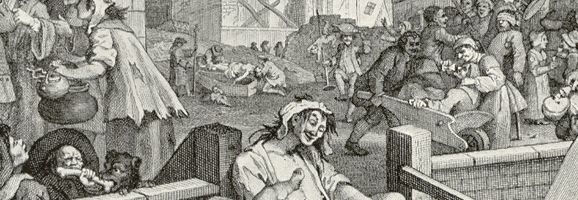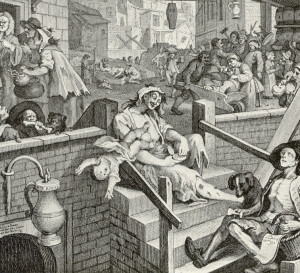
It can hardly be overstated just how serious the effects of cheap alcohol and in particular, Gin, had on the East End of London. London was hit by what social historians call ‘The Gin Craze’ during the Eighteenth Century, and it was to spawn so many of the social problems we associate with the over-crowded, slum-ridden East End.
Gin was originally created in Holland, and only became a popular drink in England when Dutch-born William of Orange took the English throne in 1688. Distillation had been widespread throughout Europe in the Middle Ages, but it was fairly uncommon in England, compared to beer and ale production. However, in 1689, Parliament banned imports of French wines and spirits and at the same time it lifted the restrictions on spirit production in Britain. As a result, anyone who could pay the required duties could set up a distillery business. Distillers became not only producers, but also sellers and the cost of gin fell below the cost of beer and ale. Gin rapidly became the favourite alcoholic drink among the ‘inferior classes’.
For a few pennies, the poor of East London found a way of escaping from the cold, hunger and grinding poverty of their lives, by drinking their woes away. It was estimated that the average Londoner drank a staggering 112 pints of Gin a year – that is a pint of raw spirit every three days. It was estimated that by 1750, over 7 million gallons of Gin was being drunk a year compared to around 3 million gallons of ale…
Gin sellers would roam the streets pushing carts filled with cheap gin, and seedy gin shops would advertise: “Drunk for one penny, dead drunk for two, clean straw for nothing.” The straw was used to lie on while sleeping off a hangover.
Women, in particular, seemed to favour gin and often purchased it from Chemists as a medicinal drink. It was often mixed with warm water to ‘soothe the nerves’ and became known as Mother’s Ruin.
The effects were devastating. Gin was blamed for misery, rising crime, prostitution, madness, high death rates and falling birth rates. The Vice-Chamberlain of the time, Lord Hervey, commented that, “Drunkenness of the common people was universal, the whole town of London swarmed with drunken people from morning till night.”
In one notorious case, a woman named Judith Dufour collected her two-year-old child from the workhouse, strangled him, dumped the body in a ditch and sold the child’s new set of clothes for 1s and 4d to buy gin.

‘Gin Lane’ by Hogarth
Finally, the government was forced to act. In 1729, they imposed an excise licence of £20 and levied a duty of two shillings per gallon. This almost suppressed the manufacture of good quality gin, but led to a greater increase in illegal distilling and the quantity of bad quality spirits being consumed continued to rise. In London, this led to a decline in the population, as people were literally drinking themselves to death.
As demands that something be done about the appalling situation grew in fervour, the Government introduced the 1736 Gin Act. This taxed retail sales at One Pound (20 shillings) a gallon and made selling gin without a £50 annual licence illegal. However, as a direct result, over the next seven years, only two licences were applied for and issued. Reputable sellers of Gin were put out of business, but bootleggers continued to thrive without control. The bootleggers’ gin, given such colourful names as ‘Ladies Delight’ and ‘Cuckold’s Comfort’, was often flavoured with turpentine rather than juniper, and in some cases was poisonous. There were even instances of it containing appalling ingredients such as sulphuric acid.
In 1751, the artist William Hogarth published his satirical print ‘Gin Lane’, (see picture) which depicts such disturbing scenes as a gin-crazed mother, legs covered in syphilitic sores, unwittingly dropping her baby to its death down some cellar stairs while she takes a pinch of snuff.
Fuelled by such powerful propaganda, the 1751 Gin Act was passed. This was finally more successful, as it served to lower the distillation licence fee and forced distillers to sell only to licensed retailers trading from respectable premises. A series of poor harvests caused a rise in food prices and a decline in wages, so the poor were less able to afford the spirit and by 1757, the Gin Craze was all but over…
